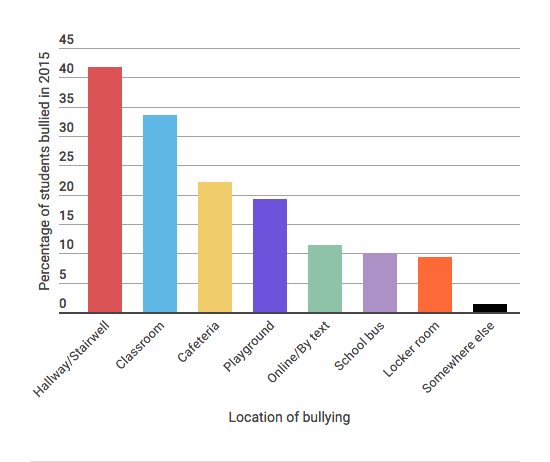Editor’s note: This article pairs with “The psychological effects of bullying.”
More than one in five students were bullied in 2016 — an increase of more than five percent since the year 2000, according to reports released by both The National Center of Educational Statistics and Bullying Police USA Inc.
According to several local school teachers and administrators, regardless of the form bullying takes, the key to addressing it may be found in the New Testament’s golden rule: Love your neighbor as yourself.
“There are three requirements for behavior to be classified as bullying,” Cherstine Willis, vice principal at Saratoga Shores Elementary School in Saratoga Springs, said. “It needs to be repetitive, premeditated and targeted.”
According to Child Trends, a nonprofit research organization focused on improving the lives of children and their families, bullying can take many forms, including physical, verbal and online.

Willis explained that physical and verbal bullying are most prevalent among children in middle school.
“Children are very vulnerable at that age,” Willis said. “They are trying to figure things out because their bodies are beginning to change.”
Willis, who regularly teaches on the elementary school level, said bullying does occur in elementary school but is not as frequent as it is in junior and senior high school.
“There are more teachers present and the children are a little better-protected,” she said. “But students start to do stupid stuff in junior high. I think it’s because they’re left on their own more in junior high school than they were in elementary school.”
Jeff Ward, a teacher at Timpview High School in Provo, agrees.
“The most overt bullying that I’ve seen has been at the middle-school level,” Ward said. “I don’t see it as much at the high school level.”
Ward added that eighth grade is where he has seen the most physical and verbal bullying occur.
“It’s partly an age thing,” he explained. “Most of the time it happens with younger kids in the eighth, ninth and tenth grades.”
Ward said children who lack size, strength and confidence are often preyed upon by bullies. But, he added, “Anything out of the norm can make you a target — anything that brings undue attention to yourself.”
Unfortunately, Ward said, as children get older and progress into high school, bullying usually takes on another, more harmful form.
“In high school, cyberbullying becomes more prevalent and more brutal,” he added.
According to Ward, cyberbullying can be much worse than other forms of bullying because the internet gives people the opportunity to follow victims and hide behind anonymity.
“It’s everywhere,” he said. “If you’re online at all, it’s there. There’s really no safe place because it can go anywhere you can go.”
Ward said when his own daughter was in tenth grade, she was cyberbullied.
“There was a website created by people at her high school that ranked every girl there, not just by their looks but also by rumors that were spread about them,” he said. “She was on that list.”
Because of the brutality and longevity of cyberbullying, Ward said it can often have a longer impact on children than other forms of bullying.
Ruel Haymond, a high school teacher at American Heritage School in American Fork and former director of American Leadership Academy in Spanish Fork, added cyberbullying is often worse because it doesn’t take place in person.

“With cyberbullying, you don’t have to face the person” being targeted, he said. “In situations like these, typically people go beyond what is considered normal decorum for bullying.”
Haymond likened cyberbullying to the book “Lord of the Flies,” by William Golding.
“That’s what’s scary about people in that story,” Haymond said. “Once they started putting on the masks, they became animalistic and cruel.”
According to the Journal of Bullying and Social Aggression, bullying doesn’t stop at the high school level.
The Journal reported that 63.35 percent of students surveyed witnessed bullying in some capacity since starting college, while 27.15 percent reported being victims of bullying.
“Bullying never fully ceases,” the report said. “Certain factors, including gender, race/ethnicity, sexual orientation, obesity, disability and not fitting in with peers increase the risk of being a victim.”
Haymond added religious belief to the list. He said although people will always be bullied because of their weight, gender, physical weaknesses, race and so forth, he believes it is becoming more common for people to be bullied because of their morality stemming from religious tenets.
“I think we are moving in a direction where anyone who believes in a moral law, absolute rights and wrongs, certain definitions of marriage and proper moral behavior will be the major targets of bullying online,” he said.
In this audio clip, Haymond explains that the best place to learn how to deal with bullies is within the home:
So, what can be done?
Willis said people have to take a proactive approach and teach children at a young age, both in the home and at school, the differences between right and wrong, compassion and anger.
“We try to empower them,” she said of her school. “We promote kindness.”
Ward added that sometimes other people have to get involved, like teachers, administrators or even police officers.
“I want my students to know that I am there for them,” he said. “I can be their advocate.”
Haymond said the solution to bullying ultimately comes down to the two great commandments found in the Bible: loving God and loving your neighbor. And to counteract bullying, he added, people have to respond softly.
“The vast majority of bullies are just wounded,” said Haymond. “People need to learn how to counter their pain by looking for ways to serve and by turning the other cheek. The concepts we learn from the New Testament — the Beatitudes and the Sermon on the Mount — are really the best strategies.”
Although bullying continues to be prevalent and seems to be increasing, it can be fought, according to Haymond. The answer, however, doesn’t necessarily lie in external coercion or punishment.
“People can change,” said Haymond. “But it has to come from within.”




